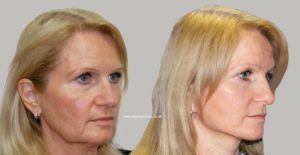Facelift
Deep Plane Facelift
The deep plane facelift is an advanced surgical technique designed to address signs of aging in the midface, jowls, and neck, offering a more comprehensive and natural-looking rejuvenation compared to traditional facelift methods. This technique focuses on repositioning and lifting the deeper layers of the face, specifically targeting the superficial musculoaponeurotic system (SMAS) layer and the structures beneath it.
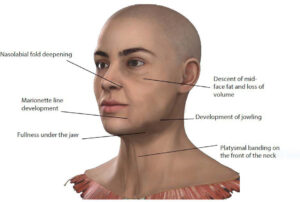
Concept and Anatomy
The deep plane facelift goes beyond just tightening the skin or the immediate underlying SMAS layer. It involves careful dissection below the SMAS, releasing facial ligaments that tether the skin to deeper structures. This allows for the mobilization of a composite flap consisting of the skin, SMAS, and deeper facial muscles as a single unit. By addressing these deeper structures, the technique achieves more natural and lasting results, reducing the tension on the skin that can lead to a “pulled” appearance. As the operation involves navigating the deeper layers of the face, the anatomy of the facial nerves needs to be thoroughly understood.
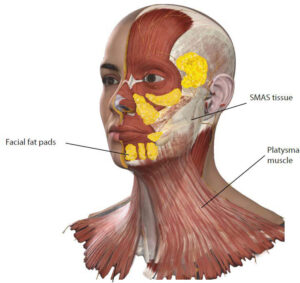
Indications
Ideal candidates for a deep plane facelift are individuals with significant sagging of the midface and lower face, pronounced nasolabial folds, jowling, and possibly neck laxity. Patients seeking correction of these issues, desiring a more youthful and refreshed appearance with long-lasting results, may benefit from this procedure. Mr Nduka will examine you for your suitability. In some cases, especially where the patient is a second opinion or corrective surgery, a deep plane is preferable, especially if the previous surgeon has performed a simpler technique.
Procedure Steps
1. Anaesthesia: The surgery is typically performed under general anesthesia or intravenous sedation to ensure the patient’s comfort.
2. Incision: Incisions are made around the hairline and ear, similar to traditional facelift techniques, but may vary depending on the extent of the lift, your particular circumstances (e.g. hair loss, thinning hair) and approach such as combining it with a brow lift.
3. Dissection: Unlike the traditional facelift that lifts only the SMAS layer, the deep plane technique involves deeper dissection. The surgeon carefully separates the skin and SMAS from the deeper muscles and ligaments, allowing for significant mobilization of the facial tissues as a single unit.
4. Repositioning: The mobilised composite flap of skin and SMAS is then repositioned and secured to create a more youthful facial contour. This step addresses sagging in the midface, reduces the depth of the nasolabial folds, lifts the jowls, and enhances the jawline.
5. Excess Skin Removal and Closure: Any excess skin is trimmed, and the incisions are meticulously closed to minimise scarring.
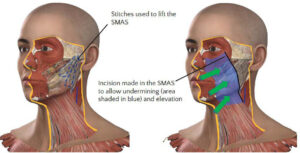
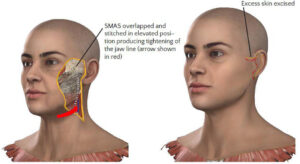
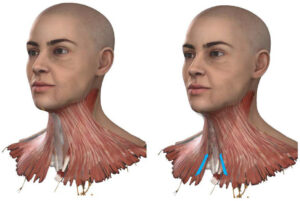
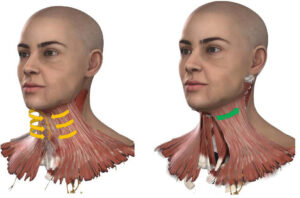
Recovery and Outcomes
Recovery from a deep plane facelift can vary but generally involves a period of swelling and bruising, with most patients returning to normal activities within 2 to 4 weeks depending on your occupation. The results are more natural-looking rejuvenation, with improvements in facial volume, contour, and reduction in sagging. Because the deeper structures are lifted, the outcomes are typically longer-lasting than those of traditional facelifts.
Risks and Considerations
As with any surgical procedure, the deep plane facelift carries risks such as bleeding, infection, nerve injury, and scarring. It’s important to ask you surgeon specifically whether they have experience with this technique and training in operating around facial nerves. It requires advanced surgical skill and understanding of facial anatomy to perform safely and effectively.
Overview
A cosmetic surgeon performs facelift under general or local anaesthesia. It lifts the jowls, tightens the jawline and rejuvenates the lower face. For a more harmonious result, the surgeon combines it with eyelid surgery and a brow lift, which is a so-called full facelift.
The term facelift is a general term and encompasses a number of procedures. Other terms used include Full facelift, Mini facelift, Short scar facelift, S-lift, Simoni lift, MACS lift, midface lift, SMAS facelift, the concept facelift™. Often for the purpose of marketing, surgeons use many of these terms interchangeably. The key point is safety and a natural-looking result. Mr. Nduka performs no two facelifts in exactly the same way because no two individuals are exactly the same (except identical twins!)
Our faces age for many reasons. Heredity, gravity, sun exposure – these all play a role. Facelifts (a procedure that is over 60 years old) intends to reverse the aging process by smoothing and redefining the contour of the neck and jawline to create a younger, fresher appearance. No other kind of surgery allows the surgeon more creativity, and no other kind of surgery is more deeply personal for the patient. Because the results are always on show, it is vital that you do careful research and ideally sees more than one surgeon for a consultation. Performing a facelift well takes years of experience and your surgeon should be able to show you results from many years ago.
One of the most difficult things about deciding to undergo surgery is the understandable desire for a quick fix. Unfortunately, Mr Nduka sees many patients for second opinions who have undergone so-called “lunchtime facelifts”, thread lifts which have left patients with either irregular contours or resulted in a lift that lasted a matter of months.
Gravity pulls at soft facial tissues, and trying to support them with threads is frequently ineffective in less than a year. In time our cheeks begin to sag, the crease running from the nostrils to the sides of the mouth (nasolabial fold) will accentuate, and our jawline and chin lose their smooth, refined appearance. As we age we also lose some of our facial fat and our skin becomes less elastic, leading to wrinkling and sagging of our skin, which affects our features.
Sun exposure can be a major contributor to accelerated aging. People who live in climates where the sun is strongest often suffer from prematurely aged skin, irrespective of their ethnic characteristics. Other factors, such as smoking and drinking alcohol, especially if done to excess from a young age can prematurely age the skin.
Years of research, and the cumulative experience of surgeons have led to an increasingly sophisticated understanding of the ageing process and the more subtle elements in the anatomy of the face. From this, techniques have developed to restore a more naturally youthful appearance.
A facelift can help refresh your appearance, but it will not erase permanent creases, particularly those around your mouth. Surgeons can perform additional procedures at the same time as your facelift like chemical peels which can diminish those lines.
Your consultation
When you meet with Mr Nduka, you have an opportunity to receive information and ask any questions about the results you would like to achieve. He will tell you what will happen during your surgery and help design a procedure that meets your individual needs. It is often helpful to bring photographs of yourself when you considered you looked your best (10-15 years previously). Ideally, these pictures should show you from the front and from the side, and if possible without a smile as this masks the jowls.
Mr Nduka will take a detailed medical history and ask about any previous facial surgery or non-surgical treatments you may have had. If you are a smoker, please discuss this with Mr Nduka as it may delay healing and affect your recovery.
He may also speak about normal differences in your facial symmetry, some of which you may have never noticed previously. Mr Nduka will, in all likelihood, gently manipulate your facial skin. This performs a dual purpose; assessment of your skin and to show you the type of result you may expect after surgery.
You should receive a comprehensive explanation of the other effects of your facial surgery, particularly in relation to your hairstyle. For men the beard area may move so that it is slightly under and behind the ear, necessitating shaving in that area.
Mr Nduka will also discuss with you the risks, which may include scarring, bleeding, and infection. He may also explain additional procedures to improve the overall results of facelift surgery. These can all be tailored to meet your individual needs and include; deep (SMAS) lifts; chin fat removal and; remodeling of the neck muscles.
Facelift definitions
FULL FACELIFT – whilst a facelift commonly means rejuvenating the lower face and jawline, it also describes rejuvenation of the whole face, typically by means of a brow lift and eyelid surgery.
MINI FACELIFT – a mini facelift is performed under general or local anaesthetic for younger patients without sagging of the neck, and often involves a shorter scar. It is often combined with eyelid surgery or a brow lift.
SHORT SCAR FACELIFT – This cosmetic surgery procedure performed under general or local anaesthetic is suitable for those with earlier signs of ageing.
S LIFT – also known as the Simoni lift or S-lift. Although this type of facelift involves less disection, the MACS lift has largely replaced it.
MACS LIFT – a facelift technique popularised by Patrick Tonnard and is a modification of the S-lift. This cosmetic surgery procedure is suitable for those with earlier signs of ageing.
MIDFACE LIFT – a technique for enhancing the cheeks and performed with incisions hidden in the hair and inside the mouth. A mid facelift is particularly suitable for those with flat cheeks but minimal loose skin.
SMAS FACELIFT (Superficial Musculo Aponeurotic System) – this is the traditional facelift technique.
SMAS facelift techniques involve either lifting a flap of SMAS, removing a strip, and stitching it into place (SMASectomy), or folding it on itself (SMAS plication)
CONCEPT FACELIFT™ – This is a marketing term for an operation that is very similar to the MACS lift. The advantage is that it requires a local anesthetic and is quick. There does not appear to be published peer-reviewed evidence on whether the results last as long as other SMAS based techniques
In addition, there are additional procedures that can be done at the time of your facelift, such as:
• blepharoplasty (eyelid surgery) – this is a reduction of loose skin around the eye
• forehead or brow lift
• the use of fat from other parts of your body to plump up particular areas in your face (Coleman fat transfer)
• midface endoscopic lifts for more definition of the cheekbone area.
These can all be tailored to meet your individual needs and include; deep (SMAS) lifts; chin fat removal and; remodeling of the neck muscles
SMAS facelift performed by Mr Charles Nduka. Note the improvement in the jowl without stretching the mouth. Dividing the mandibular ligament, a manoeuvre typically omitted with the most “minimally invasive” techniques such as the MACS lift, S lift, Concept facelift, etc. is necessary to achieve this.
What to expect from your operation
In most cases, Mr. Nduka will perform the facelift surgery typically under light general anaesthetic, and you will have to spend the following night in the hospital. Once you are comfortably asleep, he will make an incision that starts high in the temple area that is, at this point, hidden by the hair, following the curves in front of the top and bottom of the ear and behind the middle part (tragus). The incision then continues around the earlobe and up behind the ear before curving gently back into the hair.
In some cases, a second incision is made under the chin where it will also be well hidden. Its purpose is to assist with definition of the chin and neck.
Mr. Nduka will use these incisions on both sides of the face to remodel the skin, fat, and muscle. He will then close the incisions with stitches in front of the ear and clips in the hair. Fine, soft drainage tubes are inserted under the skin during the operation and are removed a day after your surgery. These help to minimise bruising and swelling around the face and neck. You may return to work and resume your normal social activities without too much delay.
The day after your surgery
Your compression garment is removed the morning after surgery. Mr Nduka will check that everything is all right. After that, your hair may be washed and you will be able to go home. You should receive a complete list of postoperative care instructions before you leave the hospital and advice such as:
- do not engage in over vigorous activity for a few days after surgery to prevent post-operative bleeding;
- you should avoid aspirin.
- take paracetamol for any pain or discomfort.
- washing of your hair is fine with a mild shampoo making sure that you do not disturb the suture area.
In the week after surgery
As you continue to convalesce, you can expect that:
- You will have your sutures removed after five to seven days.
- It is advisable not to apply any hair colour for four weeks following surgery;
- your scars will usually be very faint at first, but usually these thicken and redden for a few months after your surgery;
- it is normal to experience some bruising, swelling and numbness after a face lift.
- These symptoms are temporary and should mostly disappear after about two weeks.
- Numbness sometimes takes longer to go.
To help lessen post-operative bruising, you may take arnica for one week prior to surgery and two weeks after. Products such as arnica cream may also be useful to reduce and clear the bruises more quickly.
Possible complications
Mr Nduka would like to stress that complications are rare, but you should be fully informed of the potential side effects.
- If a haematoma should occur you may need to go back to the operating theatre. If dealt with promptly it should not affect the long-term results of the surgery.
- Occasionally, delayed wound healing may occur. This is particularly true in diabetic patients or patients who smoke.
- Damage to the facial nerves which control the muscles is extremely rare with facelift surgery.
- You will have an increased risk of clots in the leg veins with any surgery that takes more than an hour.
- It is important that, apart from the measures taken during the hospital stay, you continue gentle mobilisation,
- exercising your feet lightly but regularly in the week following operation.
- You will have to take antibiotics at the time of the surgery as a precaution.
- Infections are very rare.
Charles Nduka is a leading expert in facial palsy. Indeed some of the techniques used in aesthetic surgery were developed in his work on facial paralysis. Likewise, he uses techniques and income from his cosmetic surgery to fund improvements in the management of facial paralysis. You can learn more here Facial Paralysis | Charles Nduka – Plastic Surgery and here
Charles Nduka’s work, link here


